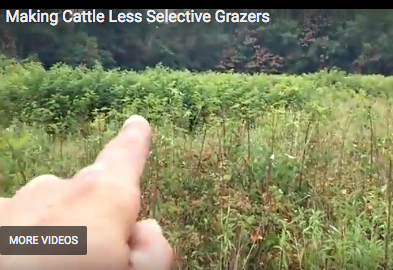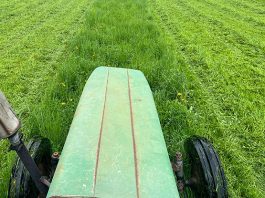
When it comes to managing brush with livestock, most people immediately think goats are the answer. In fact, that’s the answer I would have given after seven years of managing a research project and a goat herd to graze firebreaks in oakbrush. But then, working with a herd of cows in California, I had a Eureka moment: Cows are every bit as good at managing brush as goats and they’re a heck of a lot easier to work with!
Now goats as brush managers have their place too. But if you’ve already got cows, USE THEM. As an example of how to get started, check out this video from Jason Crisman of JC’s Organic Farm. His herd is eating blackberry bushes with gusto! He attributes their new foraging to his rotational grazing, fencing them into smaller paddocks so that they become less selective graziers.
Why don’t your cows eat blackberry bushes?
Like us, cows are creatures of habit and they eat what they’ve always eaten until there’s a reason to change. Many farmers and ranchers have reported that fencing has changed the behavior of their herds so that they eat things they normally wouldn’t have.
So how do you help your livestock successfully make the transition?
Simply fencing cattle in and starving them until they decide to eat something new is a recipe for disaster.
One method is to train them to eat new things. In 2002 I developed a method to quickly teach cows (and other animals) to try new foods. It takes just 8 hours spread over 7 days, and as long as you keep one educated animal on your place, you’ll never have to do it again. You can find out more about how to turn your livestock into weed eaters here.
Another way to transition your animals is to slowly change their expectations. If your herd is accustomed to being moved as soon as they’ve cleaned off the grass, even though there’s plenty of good forage left in the weeds and brush, alter your behavior slightly to alter theirs. Don’t move them immediately. Maybe move them when they’re hungry and place them in a smaller pasture than normal, encouraging them to fight a little for whatever is available. I don’t normally recommend this because it can also result in animals eating things they shouldn’t. So, if you choose this route, watch your cattle carefully to see how they’re learning. Make the move a little at a time and be sure you’re not causing them to lose weight. Remember, skinny cows don’t make money!
Brush and weeds make great forage.

The benefit of livestock eating weeds is that many of the weedy species are very nutritious and, based on the work I’ve done in this field, they’re the equivalent of alfalfa. Blackberry leaves and small stems are about 12% protein, making them a tasty alternative to mature grasses. Some pasture experts estimate that about 30% of a pasture may be weeds, so when your livestock eat them they’re gaining weight on forage above and beyond what you thought you had while improving your pasture. It’s a win-win situation!
What do you think? Are your cattle eating unusual things? What did you do to help them? How much better would your life be if you had your livestock take over some of the vegetation management chores at your place?




